Washington State is home to an astonishing range of owls, from the tiny Flammulated Owl to the massive Great Horned Owl. They live from the forested coast to the eastern deserts and everywhere in between.
Of the fourteen species that make the state their home, there are several rare species that you might be lucky enough to add to your birding Life List, such as the Spotted Owl and the Snowy Owl.
Head out to Mount Rainier, North Cascades, or Olympic National Park to spot up to a dozen different species, or just take a drive through the rural parts of the state and watch for hunting owls in the sky or on the ground. There are owls that are out and hunting during the day and those that emerge only at night.
In other words, owl-lovers have many options when it comes to finding their favorite birds in Washington state.
Here is the list of owls in Washington State:
- Western Screech Owl
- Northern Saw-Whet Owl
- Great Horned Owl
- Barred Owl
- Barn Owl
- Northern Pygmy Owl
- Boreal Owl
- Short-Eared Owl
- Burrowing Owl
- Flammulated Owl
- Great Gray Owl
- Long-Eared Owl
- Snowy Owl
- Spotted Owl
- Northern Hawk Owl
15 Types of Owls in Washington State
1. Western Screech Owl
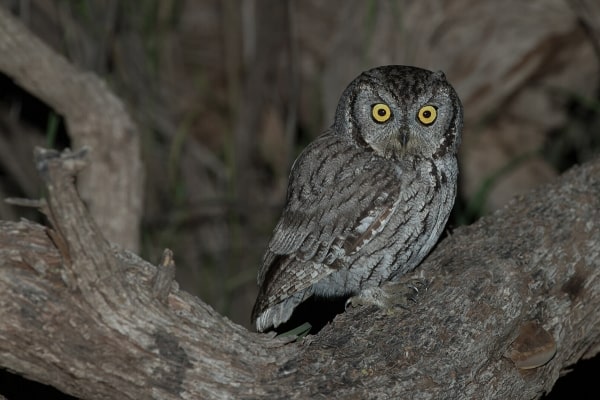
Scientific name: Otus kennicottii
Size: 7.5-10 inches long
Weight: 3.5-11 ounces
Wingspan: 21.5-24.5 inches
Western screech owls are small, about the size of a robin. But the screech they emit is anything but petite. They’re difficult to identify in the wild because they blend in super well with their environment. If you want to find a screech owl, pull up a seat outside at night and listen carefully.
The base of their body is gray, brown, or red, with a pale breast. Their body is covered in dark streaks that look extremely similar to the bark of many trees. They have yellow eyes and distinct ear tufts in a V-shape.
They’re nocturnal, and they make their home in the holes of trees and cacti, but they’ll also make their home in a nestbox in your backyard if you provide them with one. They’re common in suburban areas, and they’ll even make their home in urban parks. In Washington state, these petite owls live in the coastal part of the state as well as in patches west of the Cascade range.
While they prefer to eat small rodents, they’re powerful birds and can even pick up a full-grown rabbit.
2. Northern Saw-Whet Owl
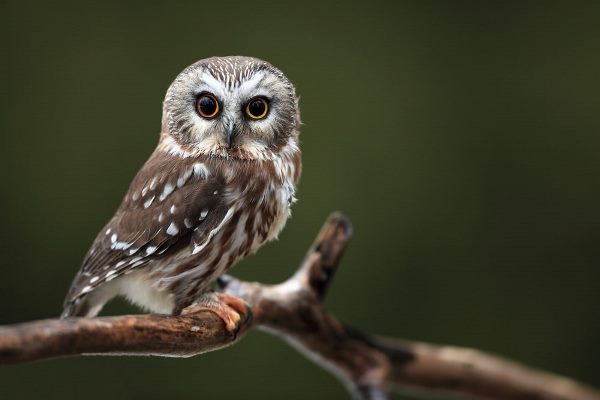
Scientific name: Aegolius acadicus
Size: 7.1-8.3 inches long
Weight: 2.5-5.3 ounces
Wingspan: 16.5-19 inches
Northern saw-whet owls are petite, about the size of a robin, with a mottled brown and white body. They have big yellow eyes and a heart-shaped face with a small, white V-mark between their eyes.
They are difficult to see, especially because they hunt at night, but if you listen for their shrill call, you’ll know they’re nearby. During the day, they nest in cavities in trees at about eye height, so you might see them if you look carefully. Don’t disturb the sleeping birds, though!
They only live in forests, particularly mature forests, so don’t look for them in open areas or cities. They migrate long distances to breed. They eat small rodents like mice and shrews. They’ll also eat birds like chickadees, juncos, waxwings, and sparrows.
They live across the US, with scarce breeding populations in the South and permanent populations in the northern part of the country and throughout the Rocky Mountains and western Coastal ranges. Nonbreeding populations exist across the rest of the country.
The northern saw-whet owl lives in the western and eastern part of Washington State year-round, with non-breeding populations passing through the central part of the state.
3. Great Horned Owl

Scientific name: Bubo virginianus
Size: 20 inches long
Weight: 32-88 ounces
Wingspan: 40-57 inches
Most people recognize the great horned owl thanks to its appearance in movies like the Harry Potter franchise and its characteristic hoot. These massive owls can weigh up to five-and-a-half pounds. They have huge claws, and they’re strong fliers, which enables them to take down fierce prey like ospreys and falcons.
Once they clench their claws around something, it takes 28 pounds of force to pry them back open again.
These birds live in every part of North America, from the bottom of Mexico to the top of Alaska. It’s one of the most common owls and makes itself at home in deserts, mountains, forests, and prairies. It lives in cities, suburbs, and wilderness areas.
You can find it anywhere in Washington state, from the coast to the border of Idaho.
Look for the large bird with yellow eyes and long tufts of hairs near its ears. They can be gray or cinnamon with barring over a cream or light gray body.
In case you were wondering, they can’t move their heads 360 degrees. They can swivel their head over 180 degrees, though, which can give the illusion that they’re turning their head completely around. They move their heads this way because they can’t shift their eyes from side to side.
4. Barred Owl

Scientific name: Strix varia
Size: 17-20 inches long
Weight: 16.6-37 ounces
Wingspan: 39-43 inches
The barred owl is similar in length to the great horned owl, but they weigh much less. They are mottled brown and white with distinct bars across their entire body. The bars on the breasts are vertical and horizontal on the rest of their bodies.
These aren’t noisy birds. They generally keep quiet, though you can hear them call out during the day sometimes.
Barred owls stick to forested areas, whether that’s the swamp or high up a mountain. You won’t find them in cities or prairies. They live across the entire eastern US and up into Canada. In recent decades, the birds have expanded their range, and now there are also populations in the Pacific Northwest. They don’t migrate during their lives. They just stick to one place, where they make their home in trees. However, if they can’t find food, they will travel long distances to hunt.
Great horned owls hunt the barred owl, while the barred owl is forcing the spotted owl, which is endangered, out of its territory.
Barred owls live in the eastern and coastal part of the state but not the central area just east of the Cascade range.
5. Barn Owl

Scientific name: Tyto alba
Size: 12.5-16 inches long
Weight: 14-24.7 ounces
Wingspan: 40-50 inches
The barn owl got its name because it likes to live in abandoned barns and other buildings in rural areas. They’ll also nest in the cavities of trees. They hunt by soaring across open areas and listening for prey. As you might guess, they have incredibly good hearing.
You can tell it’s a barn owl by its distinct face. They have pure white, heart-shaped faces with large, dark eyes. Their wings and back are gray, golden, or cinnamon and somewhat mottled. The undersides of their wings are white, as is their chest, which means they look all-white from underneath when they’re flying. They don’t have any ear tufts as the great horned owl does.
Young barn owls will fly far away from where they were hatched to find their own territory, but once they find a spot they like, they stay there for life.
Barn owls can be found all across the US and Mexico except in a few parts of the central northern states like Montana and North Dakota. The owl lives in every part of Washington state except the very northeastern tip.
6. Northern Pygmy Owl

Scientific name: Glaucidium gnoma
Size: 6.3-7.1 inches long
Weight: 2.2-2.5 ounces
Wingspan: 12 inches
As you might guess from the name, this is a tiny owl. They’re brown overall with small white spots on their head and more prominent white spots on their wings and back. On the back of their neck, they have two spots that resemble eyes to scare away other predators like Great Horned Owls.
They live in forests and nest in conifers, which is why they’re prevalent in the Pacific Northwest and in much of the Rocky Mountains. Those birds hunting in Washington State can find this petite owl in the eastern three-fourths of the state. They don’t migrate, but stay in the same area for their entire lives. They will move to lower elevations during the coldest time of the year.
Like many other owls, they nest in cavities in trees. They don’t make the hole themselves, though. They look for holes left by other animals or natural decay.
Northern pygmy owls eat small birds, lizards, insects, and mammals, but they might even snag themselves a larger bird like a quail. They hunt during the day.
7. Boreal Owl

Scientific name: Aegolius funereus
Size: 8.3-11 inches long
Weight: 3.3-7.6 ounces
Wingspan: 21.5-24.5 inches
Boreal owls live in the eastern two-thirds of Washington state on the east side of the Cascades. They stick around the same general area for their whole life, but they will travel if they can’t find food in their neighborhood. They stick to forests and prefer the high mountains. However, if you live near a mountain or forested area, you can place a nest box in your backyard, and they might come to live.
These owls hunt at night, looking for small mammals. But they don’t fly around actively hunting. Instead, they sit in a tree and patiently wait for a rat or mouse to run across the ground. Then they attack.
Boreal owls are adorable. They’re about the size of a robin, with a large square head. They’re brown overall with white mottling on their bodies and a mostly white face. The females are double the size of the males.
8. Short-Eared Owl

Scientific name: Asio flammeus
Size: 13.4-17 inches long
Weight: 7.3-16.9 ounces
Wingspan: 33.5-40.5 inches
If you guessed that these owls have short ear tufts, you’re right. Owls have ear tufts to help direct sound to their ears, enabling them to hunt and hear potential predators. Short-eared owls have ear tufts, but they’re extremely small, like tiny horns.
They’re distinctive owls because they have brown and white mottling edged in black bars. The face is cream with dark black outlines around the yellow eyes.
Their distinctive appearance makes it easier to spot them, but the fact that they are active during the day makes it even easier to see them. They even have a distinct, moth-like flight pattern that makes identification even simpler.
Unlike many owls, they don’t prefer wooded areas. They like open fields and grasslands, where they sit on the ground and watch and listen for prey to catch. Then, they fly up and dive down to catch their prey. They even nest in the ground.
They live in Washington state all year round, while some populations travel north to Canada to breed and to the southern part of the US during the non-breeding season.
9. Burrowing Owl
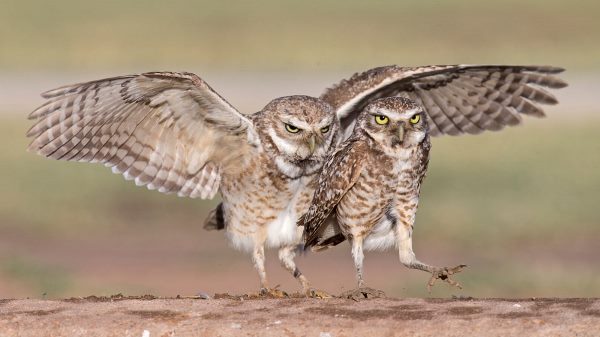
Scientific name: Athene cunicularia
Size: 7.5-9.8inches long
Weight: 5.3 ounces
Wingspan: 21.5 inches
Most owls live in the trees or shrubs, but burrowing owls have long legs that they use to run along the ground in prairies, deserts, and grasslands. They hunt for rodents and then live in tunnels that have been abandoned by animals like ground squirrels and prairie dogs.
They’ll even hunt small rodents and then take over their burrows. If that’s not available, they’ll live in pipes or tubing.
They’ve adapted to life underground by developing a high tolerance for carbon dioxide, which builds up in underground spaces.
To identify them, look for long-legged owls with mottled brown coloring and bright yellow eyes. They have flat heads.
Burrowing owls only live on the eastern edge of Washington State and only during the breeding season.
10. Flammulated Owl

Scientific name: Psiloscops flammeolus
Size: 5.9-6.7inches long
Weight: 1.5-2.2 ounces
Wingspan: 15.9-16.1 inches
The Flammulated owl is tiny. It’s barely larger than a sparrow. These are night-hunting owls that roost in trees during the day. At night, they swoop out to spot their insect prey and devour it.
They live in coniferous forests in the western part of the US. You can find them in a few areas in central and northeastern Washington State during the breeding season. They spend their time year-round in Mexico.
For such a tiny bird, you might mistake them for something much, much larger if you only hear their call. They have a deep, booming hoot that makes them sound large. This helps them scare away other predators.
Look for a tiny owl with feathered ear tufts and vertical stripes on the belly. They have dark eyes and a grayish back.
11. Great Gray Owl

Scientific name: Asio flammeus
Size: 24-33inches long
Weight: 24.7-60 ounces
Wingspan: 53.9-60 inches
Great gray owls are one of the largest owls in the US. They are larger than a Great Horned Owl, but they are a bit lighter. They sit somewhere in size between a goose and a crow.
As the name suggests, they are gray with silver, white, and brown streaks or bars. They have bright yellow eyes surrounded by brown circles, along with a white “X” between their eyes. They lack ear tufts but have a large, round head.
They dislike being near humans or human settlements, so they’re hard to find. They’re also fairly quiet. They don’t make a lot of noise when they fly, and they don’t call out often.
Great Gray Owls live in coniferous forests and hunt small mammals. In Washington State, you’ll find this owl in the eastern third all year long. They don’t usually move their home unless they travel a bit further south or to lower elevations during the cold weather.
12. Long-Eared Owl
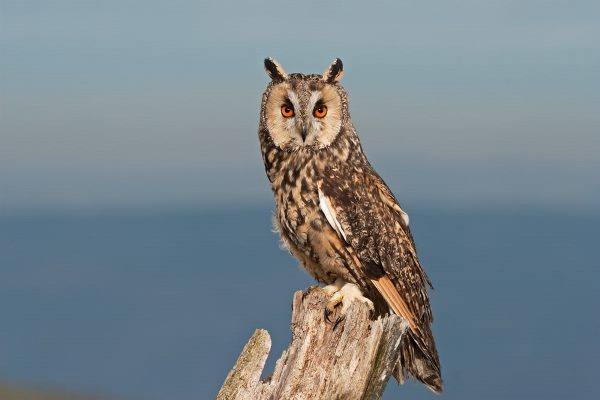
Scientific name: Asio otus
Size: 13.8-15.8 inches long
Weight: 7.8-15.3 ounces
Wingspan: 35.5-39.5 inches
Long-eared owls have surprisingly long ear tufts, which is how they got their name. The tufts are black with bits of buff or orange. They have two white lines between their yellow eyes.
They’re quite slender with mottled brown bodies.
These nocturnal birds roots in trees and hunt in grasslands or open country.
You can often identify them by their hoots, squeals, and barks. They are quite vocal. They usually only migrate at night, but they can fly exceptionally long distances. Researchers have identified birds that have traveled from Canada to Mexico in a single year.
Those who live in or are visiting Washington State have lots of opportunities to add these owls to their life list. That’s because they stay year-round in the central part of the state and hang out on west of the Cascade range during the nonbreeding season. During the breeding season, you can find these owls in the eastern part of Washington.
13. Snowy Owl

Scientific name: Bubo scandiacus
Size: 20.5-28 inches long
Weight: 56.5-104 ounces
Wingspan: 49.5-57 inches
Snowy owls are striking birds. The males are mostly white with bright, cat-like yellow eyes. The females and immature birds have dark brown or black spots. The males become whiter as they age.
Snowy owls live in the Arctic Circle, where they hunt for mammals such as lemming and ptarmigans during the long summer days. They travel south to Canada, Alaska, and the very northern parts of the US during the winter months.
Most of the time, you can see them sitting on the ground near their hunting areas. They’ll also perch on power or telephone poles, fences, and hay bales. They fly low to the ground as they scan the tundra or fields where they hunt.
In Washington State, look for these owls in the northernmost part of the state during the winter months.
This is a fairly rare bird to see, especially because their populations are declining.
14. Spotted Owl
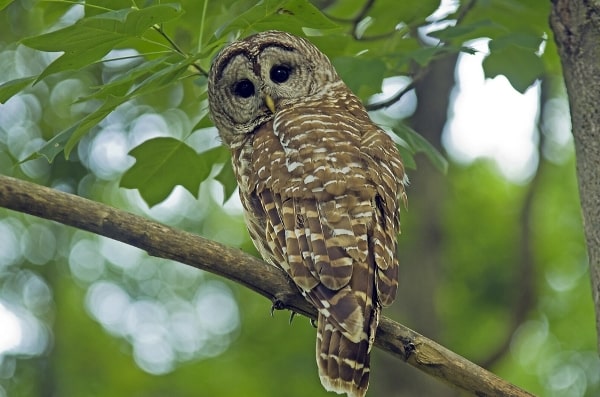
Scientific name: Strix occidentalis
Size: 18.5-19 inches long
Weight: 17.6-24.7 ounces
Wingspan: 40 inches
Spotted owls have white spots, as the name suggests, but they look dark brown overall. You’ll see more white spotting on the chest and less on the back and wings. They have distinct dark brown facial disks with a white “X” between the eyes, which are brown.
These nocturnal birds hunt for small mammals like rats and squirrels. Once they spot their prey, they silently fly down and snatch them up. They live and hunt in mature forests, but since many are being cut down, the spotted owl population is in decline.
This bird is federally protected, but logging, habitat loss, and competition from Barred Owls are driving down populations.
Consider yourself fortunate if you’re able to spot one. They’re relatively rare. Go out at night and listen for their hooting.
There are three subspecies, which are the Northern Spotted Owl, the California Spotted Owl, and the Mexican Spotted Owl. In Washington State, you’ll see the Northern Spotted Owl in the old-growth forests.
15. Northern Hawk Owl

Scientific name: Strix occidentalis
Size: 14.2-17.7 inches long
Weight: 8.5-16 ounces
Wingspan: 27.9 inches
The Northern Hawk Owl gets its name from the fact that it behaves like a hawk, but it’s actually an owl. They hunt by sight, have a long tail, and perch at the top of trees, much like hawks do. But they have round heads, yellow eyes, mottled gray, brown, and white bodies. They also have gray faces with a dark border, making them look distinctively owl-like.
For the most part, they hunt during the day, but you might see them looking for food at night in the forests where they make their homes.
These birds live in the northern parts of Canada, but if food is scarce during the winter, they will head south to the US. Birdwatchers in Oregon might be lucky enough to see them in the state’s northernmost part.
Also Read: Woodpeckers in Washington State
